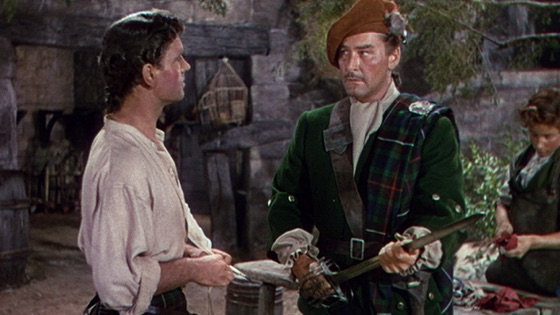The Jacobite rising of 1745 was a disaster for much of Highland Scotland that led to the weakening of the traditional clan system and the Act of Proscription, which outlawed wearing the kilt, except as a soldier or officer in the British Army. The Master of Ballantrae, loosely based on Robert Louis Stevenson’s novel of the same name, uses the rising as a backdrop for a swashbuckling adventure, with light historical trappings.
It’s 1745 and Charles Edward Stuart—known romantically to posterity as Bonnie Prince Charlie—has landed in Scotland, intent on raising an army to take back the British throne. Jamie Durie (Errol Flynn), the boisterous Master of Ballantrae and son of the local laird, Lord Durrisdeer (Felix Aylmer), is eager to fight for the Stuarts. The Duries have always supported the Stuarts. Even if they hadn’t, Jamie’s appetite for danger would lead him to the battlefield anyway. When Lady Alison (Beatrice Campbell), the laird’s ward and Jamie’s sweetheart, chides him for his recklessness, he teasingly replies he enjoys “blood for breakfast”.
Jamie insists on fighting but so does his younger, level-headed brother Henry (Anthony Steel). The laird’s steward (Mervyn Johns) devises an ingenious way for the Duries to ensure they’re on the winning side: fight on both. Or rather, have one son join the Stuarts while the other remains loyal to the Hanoverians. No matter which side wins, the family title and estate will be secure. Delighted, Jamie tosses Henry for the honour of joining the rising and wins. Then the Jacobites lose. On the run from the Redcoats and having forfeited everything he owns to Henry, Jamie is forced into exile.
The Master of Ballantrae offers no deep meditations on the Jacobite rising and its aftermath—it isn’t that sort of film. Instead director William Keighley and screenwriter Herb Meadow (with additional dialogue by Harold Medford) give audiences a briskly-paced adventure which moves swiftly from one action sequence to the next, with just enough dialogue to fill in the gaps.
One of the film’s greatest strengths is Jack Cardiff’s cinematography. An undisputed master of Technicolor, Cardiff works wonders with everything from a tiny cottage lit only by candlelight to fog-swathed cliffs (the film shot exteriors on location in Cornwall and Scotland) and a pirate ship, white sails billowing over a clear blue sea.
Keighley was no stranger to swashbucklers: he directed Flynn in The Prince and the Pauper and The Adventures of Robin Hood, the latter alongside Michael Curtiz. In The Master of Ballantrae he knows how to get the best out of a game cast. Roger Livesey, smoky-voiced and puckish, provides most of the film’s laughs as Colonel Francis Burke, an Irish mercenary full of blarney, and Jamie’s partner in arms. Jacques Berthier is delightfully arch as a foppish French pirate captain. Beatrice Campbell isn’t given much to do except worry over Jamie, but does it well. And Errol Flynn is in his element as a charming rogue who bears no resemblance to the villain of Stevenson’s novel, and plays magnificently to all of Flynn’s strengths.
The Master of Ballantrae was Keighley’s last film. It was also Flynn’s last for Warner Bros. after 18 years and 35 films, including some of the best swashbucklers ever made. There’s nothing in Ballantrae to rival Captain Blood or The Sea Hawk, but the film holds water thanks to entertaining performances and Cardiff’s photography. If nothing else the sight of Flynn on deck, a sword at his hip, is proof that no one ever swashed a buckle quite like him. And no one ever will.

Leave a Reply